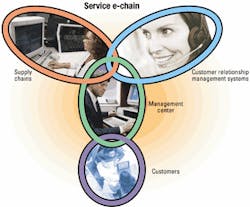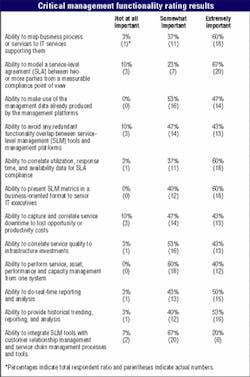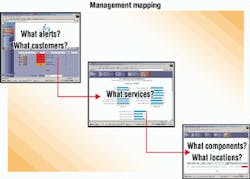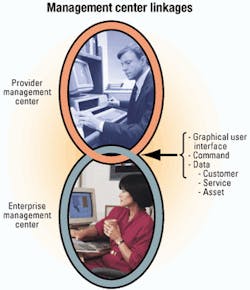Making the case for unified management
The service management community needs to embrace a supply-chain management approach similar to what is used by mainstream business.
JOHN MORENCY,
Opticom Inc.
The continuing need for connectivity, especially broadband-class connectivity to support an evolving set of enterprise business-to-business (B2B) services is clearly one of the primary growth drivers. In addition, the shift toward extending the life of existing connectivity is evident in recent data reported by Vertical Systems Group (Dedham, MA) that shows revenue from so-called legacy ATM services grew 45% over the past year-from $1.1 billion in 2000 to $1.6 billion in 2001. Increasing demand for higher speed access ports for broadband Internet connectivity, multimedia applications, and the aggregation of lower speed frame relay traffic is spurring revenue growth.
However, high-speed connectivity by itself is not satisfactory if it takes an unacceptably long time to be delivered by the provider. That is where the need for more rapid service fulfillment comes in. In a separate study, RHK projects that the North American market for telecom operation support system (OSS) service fulfillment will reach $1.8 billion in 2001-growing 17% annually through 2004 despite global downward pressure on service-provider capital expenditures.
The growth of next-generation service fulfillment is likely to occur in the enterprise as well as in the provider environment as applications such as customer self-care; provisioning of broadband services, including DSL and IP virtual private networks; support for intelligent optical networks; and deployment of 2.5-Gbit/sec and 3G wireless networks come online.
Depending on the enterprise, provisioning these services could be the responsibility of the provider, the enterprise manager, or some combination of the two. As enterprise managers are driven to take on the service business due to the increasingly stringent service requirements of their key internal stakeholders, the third option will become increasingly more common over the next few years.
However, even rapid service provisioning, while certainly necessary, is not sufficient. In order for the provider to be successful, strong attention must be paid to effectively servicing the enterprise customer across both the provider and enterprise networks simultaneously. This need will naturally evolve as provider and enterprise operations staffs are driven to work together due to major partnerships that will inevitably be formed between the business organizations of the enterprise and the provider. This level of partnership will require a shared set of corporate end-user requirements, supporting service definitions and bilateral success criteria to be exchanged and supported by both organizations.Supporting this scenario, however, is a daunting technical and operational challenge. How does one integrate previously separate and distinct provider OSS and enterprise management systems in order to deliver more unified service quality that can be effectively supported by both organizations? And at what management system touch points should this integration occur?
To answer these questions, it is necessary to understand the most important enterprise operations management requirements a-long with those that best support the means by which enterprises can most successfully tap the business growth potential of the Internet. When all these requirements are considered, the following three stand out as especially significant:
- Enterprise users increasingly require products and services that have clearly demonstrable cost-cutting and/or cost-saving business cases.
- New products and services must be highly adaptable in their ability to minimally coexist with and preferably leverage the most value from the users' IT infrastructure already in place.
- New IT investments must demonstrate the ability to increase the quality of both internal and external customer service delivery, while also satisfying requirements 1 and 2 simultaneously.
The significance of these requirements is supported by the results of recent research produced by Gartner Group, a telecom research firm based in Stamford, CT. These research results and recommendations include a number of steps users must take if their shops are to survive over the long haul. These steps (in order of importance) include:
- The delivery of impeccable customer service quality.
- The demonstration and subsequent achievement of IT investment return.
- The implementation of a streamlined, yet highly effective, help desk.
- A proactive willingness to provide both IT and business consulting to either individual internal business units, actual customers, or some combination of the two.
- Building and supporting constructive customer relationship management systems.
- Implement strong IT governance in the form of effective policies and procedures.
- Serve as a trusted technology and business partner.
At first glance, many of these steps hardly seem new. Has anything really changed as a result of the onset of the e-world? The answer is a resounding yes. In fact, it is the very structure of the e-world itself that has changed the operational context in which these steps need to be implemented.
A support environment by which end-to-end services are often delivered indirectly characterizes this implementation. This delivery will happen through the integration of internal and external resources and services (a mix of "make, partner, and buy") between the enterprise and the service provider.
The nature of the relationships required to support this delivery has strong similarities with those relationships established by business units to support an increasing number of business-specific supply chains. This instance can be characterized as an IT service value chain or, more simply, as an e-service chain.
Figure 1 illustrates the key components that constitute the contemporary service chain. This figure also illustrates the assumed use of one or more provider services to facilitate the required connections (or "linkages") between each of the individual links. The nature of this linkage may be as simple as a high-speed broadband connection or as complex as a managed private B2B exchange in which a provider supports everything from the infrastructure hardware up to and including 24/7 support of shared servers and database systems.
Regardless of the provider-to-provider customer service relationship, a few key points become clear. First, the establishment and support of more complex inter-enterprise, inter-provider service chains will be required to support rapidly evolving next-generation services. Second, given that these chains support life-sustaining business channels, the need to satisfy production quality management requirements becomes mandatory.
Not so obvious, however, is that the nature of these configuration, fault, and performance management requirements strongly dictate the need for an entirely new management paradigm that was not even conceived of when simple network management protocol, common management information protocol, and transaction language-1 technologies were first introduced.This paradigm takes the definition of end-to-end management to a whole new level by not requiring the ability to selectively manage any physical or logical component that supports the networked path between requester and server. It also requires the ability to manage the nature of the linkages between adjacent and non-adjacent components in supporting one or more defined services. In addition, both components and their associated relationships should be easily and effectively navigated using little more than a conventional hyperlink as the basis for inter-component management navigation.
That is conceptually shown in Figure 2, where the inter-module relationships are shown using a service chain metaphor. The hyper-linking that is used as the basis of the module linkage enables alerts, customers, services, components, and locations to be more easily and effectively correlated in order to support both reactive and proactive management tasks. A sample screen flow is shown that enables the user to navigate directly to management information associated with specific supporting components in a manner that is both service- and customer-specific.
Given that most meaningful business-related flows of the future will be supported by a combination of enterprise and provider network components, a key requirement emerges regarding how to extend the service chain management metaphor to flow and component data that is maintained partly within an enterprise-based management center and partly within provider management centers. That drives the need for a supported service chain relationship between two previously non-integrated systems: the enterprise network management system and the OSS. This required management service chain, along with its associated linkages, is shown in Figure 3.In addition to illustrating the service chain linkage, Figure 3 also highlights the required levels of integration that must exist between enterprise and service-provider management systems in order to effectively address the crucial third user requirement-the ability to deliver superior customer service. This model forms the basis for unified service management.
In contrast to what has been the traditional enterprise management system integration scope (i.e., only at the graphical interface level), this linkage requires the ability to share an appropriate subset of service, customer, and network asset information between provider and enterprise management systems. That is necessary to ensure the enterprise and provider teams share the right level of service information necessary to deliver the mutually agreed-upon level of service quality.
These objects include service definitions, service quality objectives, customer-specific data, and detailed asset data, including product type, location, and related support. This level of data sharing needs to be defined with the objective of making both the enterprise and provider support staff more efficient and more productive, particularly in their interaction with one another. When a common language and set of definitions are used, it significantly enhances the ability of all parties to communicate far more effectively and increases the probability of shared success.
Given this set of requirements, the scope of related management functionality will likely become broader as enterprise users and providers transition from managing discrete network entities to managing both simple and complex business flows. Research shows that users' expectations are high regarding the ways in which they need to manage e-services in the future. The importance ratings assigned to 12 different categories of management functionality by more than one thousand enterprise network, system, application, and service-provider infrastructure managers are shown in the Table on page 124. Respondents were selected at random across the Internet from a global technical support professional population in both provider and enterprise environments.
Another key user requirement was giving products the ability to both coexist and derive the most value from the physical and logical infrastructure already in place. This requirement applies to either enterprise or provider networks. Addressing the first portion of the requirement-simple coexistence-is the easy part. Most vendors claim (and to some extent support) the industry standards that facilitate at least some level of interface and data exchange. Simple support of standards, while necessary, is generally not sufficient to ensure an optimum return from both existing and new information technology.
The more complex and challenging portion is how to both support and derive added value from the existing management systems and data already in place. Much of the added value will increasingly determine a product family's ability to support access to the data maintained by existing management systems. The next step is to either create new value-added management functionality based upon that data, or synthesize the data into a set of service quality and delivery information that can effectively provide meaningful decision support for both technical and business professionals.
Data mining technology has been developed that can synthesize and transform existing management data from a variety of enterprise management platforms (either separately or concurrently) to provide asset, cost, benchmarking, capacity, and service availability information. That information can then be delivered to either all or a select number of service consumers, enabling them to fine-tune their service consumption as required by business demand.
The state of the global economy combined with a usage acceleration of enterprise broadband connectivity is driving the need for products and services to demonstrate immediate and sustained value. Given the complex combination of enterprise and service-provider networks necessary to support new B2B and non-B2B broadband flows, the service management community must embrace a supply chain management approach similar to that used by mainstream business.
Until now, this level of support has not been possible due to the separate and isolated nature of the IT management systems used by both enterprises and providers. Service chain management technology has been successfully used for a number of years to support diverse management system data mining and reporting. Its natural extension into the service-provider OSS environment will result in intersystem integration at key provider system touch points that support service provisioning, trouble ticketing, customer care, and service billing.
This technology is being developed and demonstrated with key service providers today. The extension of service chain management technology to the provider OSS is not only feasible, but will soon demonstrate strong support for both the documented and related user requirements spawned over the next few years.
John P. Morency is senior vice president of marketing at Opticom Inc. (Andover, MA). He can be reached via the company's Website, www.opticominc.com.




